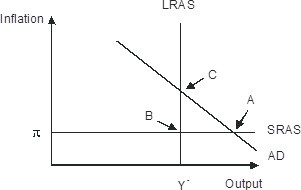The tendency for large banks to have a higher return on equity than small banks suggests:
A. larger banks are better able to escape the cost of regulation.
B. there could be significant economies of scale in banking.
C. large banks can charge higher interest rates than small banks.
D. small banks have better management than large banks.
Answer: B
You might also like to view...
In the law of torts, what is meant by a negligence standard? How does a negligence standard promote economic efficiency? How can it lead to less-than-efficient outcomes?
What will be an ideal response?
Refer to the figure below. In response to gradually falling inflation, this economy will eventually move from its short-run equilibrium to its long-run equilibrium. Graphically, this would be seen as 
A. long-run aggregate supply shifting leftward B. Short-run aggregate supply shifting upward C. Short-run aggregate supply shifting downward D. Aggregate demand shifting leftward
If you have a choice of consuming either two apples, three oranges, or one candy bar, the opportunity cost of the candy bar is:
a. two apples. b. three oranges. c. two apples and three oranges. d. two apples or three oranges, whichever you value more. e. the difference in the prices of the three options.
With rational expectations, a correctly anticipated policy that would increase AD would lead to: a. higher inflation and lower unemployment in the short run
b. higher inflation and higher unemployment in the short run. c. higher inflation and no change in unemployment in the short run. d. lower inflation and lower unemployment in the short run.